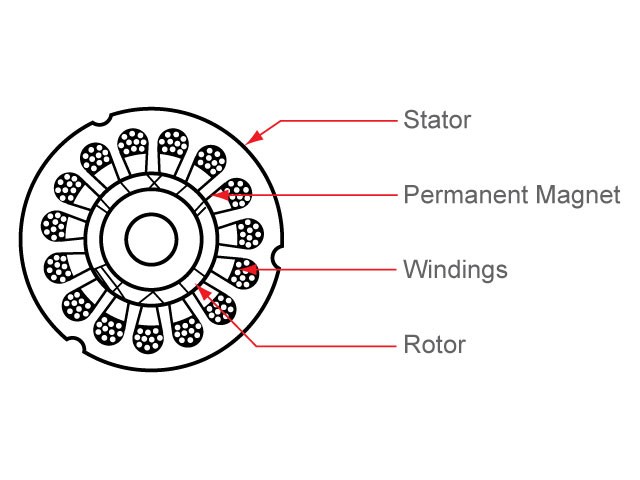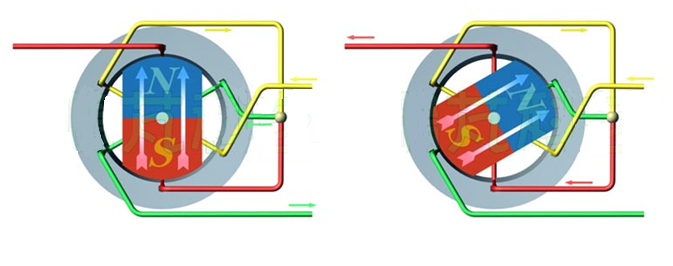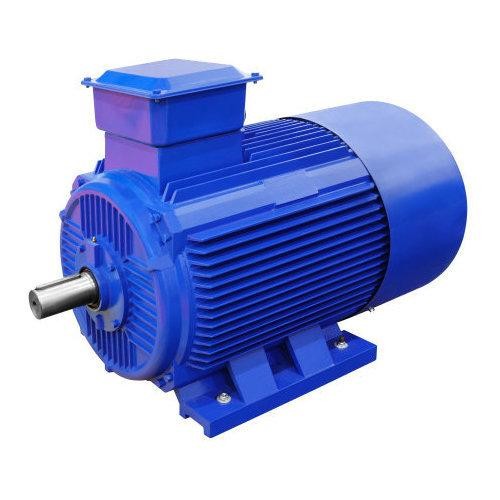QINGDAO ENNENG MOTOR CO.,LTD. |
|
Verified Suppliers
|
|
Low Rpm High Torque High-Efficiency Interior Permanent Magnet Motor

Analysis of the principle of the technical advantages of permanent magnet motor
The principle of a permanent magnet synchronous motor is as follows: In the motor's stator winding into the three-phase current, after the pass-in current, it will form a rotating magnetic field for the motor's stator winding. Because the rotor is installed with the permanent magnet, the permanent magnet's magnetic pole is fixed, according to the principle of magnetic poles of the same phase attracting different repulsion, the rotating magnetic field generated in the stator will drive the rotor to rotate, The rotation speed of the rotor is equal to the speed of the rotating pole produced in the stator.


Flux weakening/intensifying of PM motors
Flux in a permanent magnet motor is generated by the magnets. The flux field follows a certain path, which can be boosted or opposed. Boosting or intensifying the flux field will allow the motor to temporarily increase torque production. Opposing the flux field will negate the existing magnet field of the motor. The reduced magnet field will limit torque production, but reduce the back-emf voltage. The reduced back-emf voltage frees up the voltage to push the motor to operate at higher output speeds. Both types of operation require additional motor current. The direction of the motor current across the d-axis, provided by the motor controller, determines the desired effect.
Differences Between The Permanent Magnet Motor And Asynchronous Motor:
01. Rotor Structure
Asynchronous motor: The rotor consists of an iron core and a winding, mainly squirrel-cage and wire-wound rotors. A squirrel-cage rotor is cast with aluminum bars. The magnetic field of the aluminum bar cutting the stator drives the rotor.
PMSM Motor: The permanent magnets are embedded in the rotor magnetic poles, and are driven to rotate by the rotating magnetic field generated in the stator according to the principle of magnetic poles of the same phase attracting different repulsions.
02. Efficiency
Asynchronous motors: Need to absorb current from the grid excitation, resulting in a certain amount of energy loss, motor reactive current, and low power factor.
PMSM Motor: The magnetic field is provided by permanent magnets, the rotor does not need exciting current, and the motor efficiency is improved.
03. Volume And Weight
The use of high-performance permanent magnet materials makes the air gap magnetic field of permanent magnet synchronous motors larger than that of asynchronous motors. The size and weight are reduced compared to asynchronous motors. It will be one or two frame sizes lower than asynchronous motors.
04. Motor Starting Current
Asynchronous motor: It is directly started by power frequency electricity, and the starting current is large, which can reach 5 to 7 times the rated current, which has a great impact on the power grid in an instant. The large starting current causes the leakage resistance voltage drop of the stator winding to increase, and the starting torque is small so heavy-duty starting cannot be achieved. Even if the inverter is used, it can only start within the rated output current range.
PMSM Motor: It is driven by a dedicated controller, which lacks the rated output requirements of the reducer. The actual starting current is small, the current is gradually increased according to the load, and the starting torque is large.
05. Power Factor
Asynchronous motors have a low power factor, they must absorb a large amount of reactive current from the power grid, the large starting current of asynchronous motors will cause a short-term impact on the power grid, and long-term use will cause certain damage to the power grid equipment and transformers. It is necessary to add power compensation units and perform reactive power compensation to ensure the quality of the power grid and increase the cost of equipment use.
There is no induced current in the rotor of the permanent magnet synchronous motor, and the power factor of the motor is high, which improves the quality factor of the power grid and eliminates the need to install a compensator.
06. Maintenance
Asynchronous motor + reducer structure will generate vibration, heat, high failure rate, large lubricant consumption, and high manual maintenance cost; it will cause certain downtime losses.
The three-phase Permanent magnet synchronous motor drives the equipment directly. Because the reducer is eliminated, the motor output speed is low, mechanical noise is low, mechanical vibration is small, and the failure rate is low. The entire drive system is almost maintenance-free.


The motor is excited by rare earth neodymium iron boron permanent magnet materials and is supplied with a permanent magnet special frequency converter. It has the characteristics of large starting torque, wide speed range, compact structure, small size, lightweight, low noise, high power factor, and high efficiency. It is an ideal power choice for high-efficiency and energy-saving air compressors.
1. The motor can operate normally under the following conditions:
1.1 The ambient temperature does not exceed 40℃;
1.2 Relative humidity ≤90%;
1.3 The altitude does not exceed 1000m.
2. The rated voltage of the motor is 380V, also according to user requirements.
3. The reference work system of the motor: S1.
4. Insulation grade: F grade.
5. Protection level: IP55.
6. Motor structure and installation type: B3, B35.
7. The motor outlet is located on the top of the base, or it can be located on the right or left of the base according to user requirements.
8. Motor service factor: 1.15, 1.2 (or as per technical agreement).
A PM motor can be separated into two main categories: surface permanent magnet motors (SPM) and interior permanent magnet motors (IPM). Neither motor design type contains rotor bars. Both types generate magnetic flux by the permanent magnets affixed to or inside of the rotor.
SPM motors have magnets affixed to the exterior of the rotor surface. Because of this mechanical mounting, their mechanical strength is weaker than that of IPM motors. The weakened mechanical strength limits the motor’s maximum safe mechanical speed. In addition, these motors exhibit very limited magnetic saliency (Ld ≈ Lq). Inductance values measured at the rotor terminals are consistent regardless of the rotor position. Because of the near unity saliency ratio, SPM motor designs rely significantly, if not completely, on the magnetic torque component to produce torque.
IPM motors have a permanent magnet embedded into the rotor itself. Unlike their SPM counterparts, the location of the permanent magnets makes IPM motors very mechanically sound, and suitable for operating at very high speeds. These motors also are defined by their relatively high magnetic saliency ratio (Lq > Ld). Due to their magnetic saliency, an IPM motor has the ability to generate torque by taking advantage of both the magnetic and reluctance torque components of the motor.
The development trend of rare earth permanent magnet motors
Rare earth permanent magnet motors are developing towards high power (high speed, high torque), high functionality and miniaturization, and are constantly expanding new motor varieties and application fields, and the application prospects are very optimistic. In order to meet the needs, the design and manufacturing process of rare earth permanent magnet motors still need to be continuously innovated, the electromagnetic structure will be more complex, the calculation structure will be more accurate, and the manufacturing process will be more advanced and applicable.
Application of rare earth permanent magnet motor
Due to the superiority of rare earth permanent magnet motors, their applications are becoming more and more extensive. The main application areas are as follows:
Focus on the high efficiency and energy saving of rare earth permanent magnet motors. The main application objects are large power consumers, such as rare earth permanent magnet synchronous motors for textile and chemical fiber industries, rare earth permanent magnet synchronous motors for various mining and transportation machinery used in oil fields and coal mines, and rare earth permanent magnet synchronous motors for driving various pumps and fans.
Self-sensing versus closed-loop operation
Recent advances in drive technology allow standard ac drives to “self-detect” and track the motor magnet position. A closed-loop system typically uses the z-pulse channel to optimize performance. Through certain routines, the drive knows the exact position of the motor magnet by tracking the A/B channels and correcting for errors with the z-channel. Knowing the exact position of the magnet allows for optimum torque production resulting in optimum efficiency.